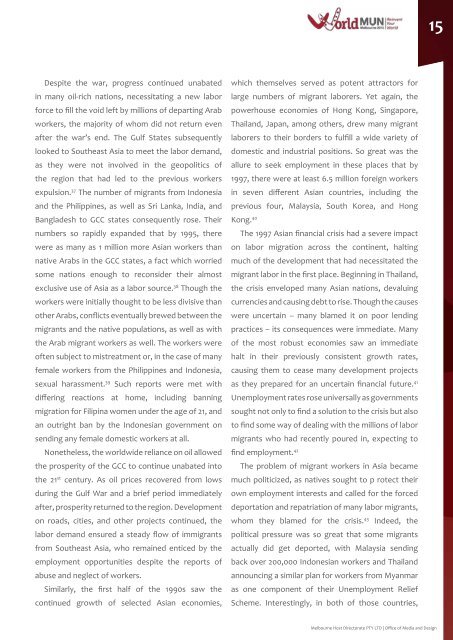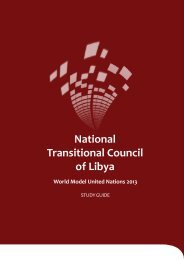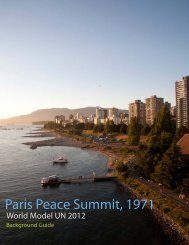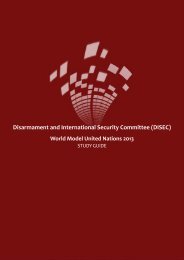SPECPOL - World Model United Nations
SPECPOL - World Model United Nations
SPECPOL - World Model United Nations
You also want an ePaper? Increase the reach of your titles
YUMPU automatically turns print PDFs into web optimized ePapers that Google loves.
Despite the war, progress continued unabated<br />
in many oil-rich nations, necessitating a new labor<br />
force to fill the void left by millions of departing Arab<br />
workers, the majority of whom did not return even<br />
after the war’s end. The Gulf States subsequently<br />
looked to Southeast Asia to meet the labor demand,<br />
as they were not involved in the geopolitics of<br />
the region that had led to the previous workers<br />
expulsion. 37 The number of migrants from Indonesia<br />
and the Philippines, as well as Sri Lanka, India, and<br />
Bangladesh to GCC states consequently rose. Their<br />
numbers so rapidly expanded that by 1995, there<br />
were as many as 1 million more Asian workers than<br />
native Arabs in the GCC states, a fact which worried<br />
some nations enough to reconsider their almost<br />
exclusive use of Asia as a labor source. 38 though the<br />
workers were initially thought to be less divisive than<br />
other Arabs, conflicts eventually brewed between the<br />
migrants and the native populations, as well as with<br />
the Arab migrant workers as well. The workers were<br />
often subject to mistreatment or, in the case of many<br />
female workers from the Philippines and Indonesia,<br />
sexual harassment. 39 Such reports were met with<br />
differing reactions at home, including banning<br />
migration for Filipina women under the age of 21, and<br />
an outright ban by the Indonesian government on<br />
sending any female domestic workers at all.<br />
Nonetheless, the worldwide reliance on oil allowed<br />
the prosperity of the GCC to continue unabated into<br />
the 21st century. As oil prices recovered from lows<br />
during the Gulf War and a brief period immediately<br />
after, prosperity returned to the region. Development<br />
on roads, cities, and other projects continued, the<br />
labor demand ensured a steady flow of immigrants<br />
from Southeast Asia, who remained enticed by the<br />
employment opportunities despite the reports of<br />
abuse and neglect of workers.<br />
Similarly, the first half of the 1990s saw the<br />
continued growth of selected Asian economies,<br />
which themselves served as potent attractors for<br />
large numbers of migrant laborers. Yet again, the<br />
powerhouse economies of Hong Kong, Singapore,<br />
thailand, Japan, among others, drew many migrant<br />
laborers to their borders to fulfill a wide variety of<br />
domestic and industrial positions. So great was the<br />
allure to seek employment in these places that by<br />
1997, there were at least 6.5 million foreign workers<br />
in seven different Asian countries, including the<br />
previous four, Malaysia, South Korea, and Hong<br />
Kong. 40<br />
The 1997 Asian financial crisis had a severe impact<br />
on labor migration across the continent, halting<br />
much of the development that had necessitated the<br />
migrant labor in the first place. Beginning in Thailand,<br />
the crisis enveloped many Asian nations, devaluing<br />
currencies and causing debt to rise. Though the causes<br />
were uncertain – many blamed it on poor lending<br />
practices – its consequences were immediate. Many<br />
of the most robust economies saw an immediate<br />
halt in their previously consistent growth rates,<br />
causing them to cease many development projects<br />
as they prepared for an uncertain financial future. 41<br />
Unemployment rates rose universally as governments<br />
sought not only to find a solution to the crisis but also<br />
to find some way of dealing with the millions of labor<br />
migrants who had recently poured in, expecting to<br />
find employment. 42<br />
The problem of migrant workers in Asia became<br />
much politicized, as natives sought to p rotect their<br />
own employment interests and called for the forced<br />
deportation and repatriation of many labor migrants,<br />
whom they blamed for the crisis. 43 indeed, the<br />
political pressure was so great that some migrants<br />
actually did get deported, with Malaysia sending<br />
back over 200,000 Indonesian workers and Thailand<br />
announcing a similar plan for workers from Myanmar<br />
as one component of their unemployment Relief<br />
Scheme. Interestingly, in both of those countries,<br />
15<br />
Melbourne Host Directorate PTY LTD | Office of Media and Design

















